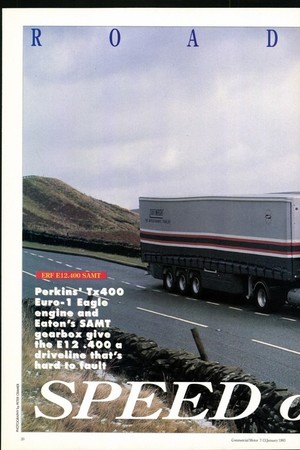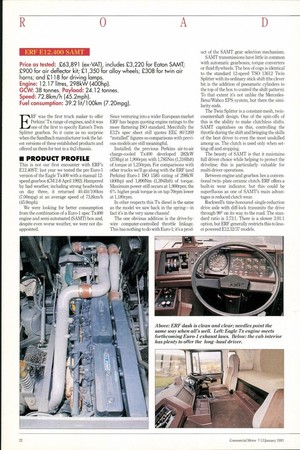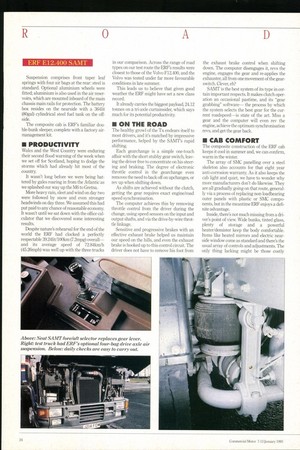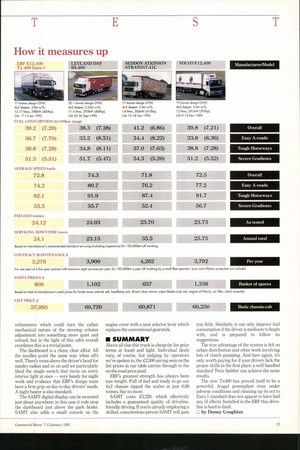PerkliA4L-TVr0 Eure-11 Eagle engine and Eaton's SAMT gearbox give the
Page 22

Page 23

Page 24

Page 26

Page 27

If you've noticed an error in this article please click here to report it so we can fix it.
E112 .400 a driven's() that's hatilaittalt , 11111# ERF E12.400 SAMT Price as tested: £63,891 (ex-VAT), includes £3,220 for Eaton SAMT; £900 for air deflector kit; £1,350 for alloy wheels; £308 for iwin air horns; and £118 for driving lamps. Engine: 12.17 litres, 298kW (400hp). GCW: 38 tonnes. Payload: 24.12 tonnes. Speed: 72.8km/h (45.2mph). Fuel consumption: 39.2 lit/100km (7.20mpg).
F F RF was the first truck maker to offer Perkins' Tx range of engines, and it was one of the first to specify Eaton's Twin Splitter gearbox. So it came as no surprise when the Sandbach manufacturer took the latest versions of these established products and offered us them for test in a 4x2 chassis.
• PRODUCT PROFILE This is not our first encounter with ERF's E12.40ST: last year we tested the pre Euro-1 version of the Eagle Tx400 with a manual 12speed gearbox (CM 2-8 Apri11992). Hampered by bad weather, including strong headwinds on day three, it returned 40.41A/1001un (7.00mpg) at an average speed of 73.8km/h (45.9mph).
We were looking for better consumption from the combination of a Euro-1 spec Tx400 engine and semi-automated (SAMT) box and, despite even worse weather, we were not disappointed. Since venturing into a wider European market ERF has begun quoting engine ratings to the more flattering ISO standard. Mercifully the E12's spec sheet still quotes EEC 80/1269 "installed" figures so comparisons with previous models are still meaningful.
Installed, the previous Perkins air-to-air charge-cooled Tx400 developed 282kW (378hp) at 1,900rpm with 1,785Nm (1,3161bft) of torque at 1,250rpm. For comparisons with other trucks we'll go along with the ERF (and Perkins) Euro-1 ISO 1585 rating of 298kW (400hp) and 1,890Nm (1,3941bf) of torque. Maximum power still occurs at 1,900rpm; the 6% higher peak torque is on tap 70rpm lower at 1,180rpm.
In other respects this Tx diesel is the same as the model we saw back in the spring—in fact it's in the very same chassis!
The one obvious addition is the drive-bywire computer-controlled throttle linkage. This has nothing to do with Euro-1; it's a prod uct of the SAMT gear selection mechanism.
SAMT transmissions have little in common with automatic gearboxes, torque converters or fluid flywheels. The box of cogs is identical to the standard 12-speed TS0 13612 Twin Splitter with its ordinary stick shift (the clever bit is the addition of pneumatic cylinders to the top of the box to control the shift pattern). To that extent it's not unlike the MercedesBenz/Wabco EPS system, but there the similarity ends.
The Twin Splitter is a constant-mesh, twincountershaft design. One of the spin-offs of this is the ability to make clutchless shifts. SAMT capitalises on this, controlling the throttle during the shift and bringing the skills of the best driver to even the most unskilled among us. The clutch is used only when setting off and stopping.
The beauty of SAMT is that it maintains full driver choice while helping to protect the driveline; this is particularly valuable for multi-driver operations.
Between engine and gearbox lies a conventional twinplate ceramic clutch. ERF offers a built-in wear indicator, but this could be superfluous as one of SAMT's main advantages is reduced clutch wear.
Rockwell's time-honoured single-reduction drive axle with diff-lock transmits the drive through 90° on its way to the road. The standard ratio is 3.73:1. There is a slower 3.91:1 option, but ERF generally restricts this to lesser powered E12.32/37 models. Suspension comprises front taper leaf springs with four air bags at the rear: steel is standard. Optional aluminium wheels were fitted; aluminium is also used in the air reservoirs, which are mounted inboard of the main chassis main rails for protection. The battery box resides on the nearside with a 3641it (80gal) cylindrical steel fuel tank on the offside.
The composite cab is ERF's familiar double-bunk sleeper, complete with a factory airmanagement kit.
• PRODUCTIVITY Wales and the West Country were enduring their second flood warning of the week when we set off for Scotland, hoping to dodge the storms Ikhich had already hit most of the country It wasn't long before we were being battered by gales roaring in from the Atlantic as we splashed our way up the M6 to Gretna.
More heavy rain, sleet and wind on day two were followed by snow and even stronger headwinds on day three. We assumed this had put paid to any chance of reasonable economy. It wasn't until we sat down with the office calculator that we discovered some interesting results.
Despite nature's rehearsal for the end of the world the ERF had clocked a perfectly respectable 39.241it/100km (72mpg) overall— and its average speed of 72.84km/h (45.26mph) was well up with the three trucks in our comparison. Across the range of road types on our test route the ERF's results were closest to those of the Volvo F12.400, and the Volvo was tested under far more favourable conditions in late summer.
This leads us to believe that given good weather the ERF might have set a new class record.
It already carries the biggest payload, 24.12 tonnes on a tri-axle curtainsider, which says much for its potential productivity.
• ON THE ROAD The healthy growl of the Tx endears itself to most drivers, and it's matched by impressive performance, helped by the SAMT's rapid shifting.
Each gearchange is a simple one-touch affair with the short stubby gear switch, leaving the driver free to concentrate on his steering and braking. The degree of electronic throttle control in the gearchange even removes the need to back off on upchanges, or rev up when shifting down.
As shifts are achieved without the clutch, getting the gear requires exact engine/road speed synchronisation.
The computer achieves this by removing throttle control from the driver during the change, using speed sensors on the input and output shafts, and via the drive-by-wire throttle linkage.
Sensitive and progressive brakes with an effective exhaust brake helped us maintain our speed on the hills, and even the exhaust brake is hooked up to this control circuit. The driver does not have to remove his foot from the exhaust brake control when shifting down. The computer disengages it, revs the engine, engages the gear and re-applies the exhauster, all from one movement of the gearswitch. Clever, eh?
SAMT is the best system of its type in certain important respects. It makes clutch operation an occasional pastime, and its "gear grabbing" software— the process by which the system selects the best gear for the current roadspeed—is state of the art. Miss a gear and the computer will even rev the engine, achieve the optimum synchronisation revs, and get the gear back.
• CAB COMFORT The composite construction of the ERF cab keeps it cool in summer and, we can confirm, warm in the winter.
The array of SMC panelling over a steel skeleton also accounts for that eight year anti-corrosion warranty As it also keeps the cab light and quiet, we have to wonder why more manufacturers don't do likewise. They are all gradually going on that route, generally via a process of replacing non-loadbearing outer panels with plastic or SMC components, but in the meantime ERF enjoys a definite advantage.
Inside, there's not much missing from a driver's point of view. Wide bunks, tinted glass, plenty of storage and a powerful heater/demister keep the body comfortable. Items like heated mirrors and electric nearside window come as standard and there's the usual array of controls and adjustments. The only thing lacking might be those costly refinements which could turn the rather mechanical nature of the steering column adjustment into something more quiet and refined, but in the light of this cab's overall excellence this is a trivial point.
The dashboard is a clean, clear affair. All the needles point the same way when all's well. There's room above the driver's head for sundry radios and so on and we particularly liked the single switch that turns on every interior light at once very handy for night work and evidence that ERF's design team have a firm grip on day-to-day drivers' needs. A night heater is also standard.
The SAMT digital display can be mounted just about anywhere; in this case it rode atop the dashboard just above the park brake. SAMT also adds a small console on the engine cover with a neat selector lever which replaces the conventional gearstick.
• SUMMARY Above all else this truck is cheap (in list price terms at least) and light. Individual deals vary, of course, but judging by operators we've spoken to, the £2,500 saving seen on the list prices in our table carries through to the on-the-road price paid.
ERF's greatest strength has always been tare weight. Full of fuel and ready to go our 4x2 chassis tipped the scales at just 6.88 tonnes. Say no more.
SAMT costs £3,220, which effectively includes a guaranteed quality of drivelinefriendly driving. If you're already employing a skilled, conscientious person SAMT will gain you little. Similarly, it can only improve fuel consumption if the driver is mediocre to begin with, and is prepared to follow its suggestions.
The true advantage of the system is felt on urban distribution and other work involving lots of clutch pumping. And here again, it's only worth paying for if your drivers lack the proper skills in the first place: a well handled standard Twin Splitter can achieve the same results.
The new Tx400 has proved itself to be a powerful, frugal powerplant even under adverse conditions and cleaning up its act to Euro-1 standard does not appear to have had any ill effects. Installed in the ERF this driveline is hard to fault.
by Danny Coughlan




























































